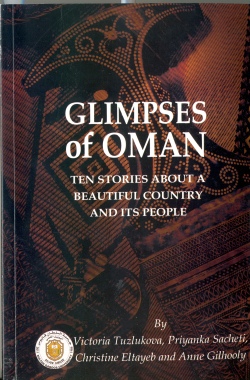Review of “Glimpses of Oman: Ten Stories About a Beautiful Country and Its People”
by Neil McBeath, Oman
Glimpses of Oman: Ten stories about a Beautiful Country and Its People
Victoria Tuzlukova, Priyanka Sacheti, Christine Eltayeb and Anne Gilhooly 2011
Muscat. Sultan Qaboos University Press
pp. 156

This is a book that has been designed for use within the Language centre at The Sultan Qaboos University. It is therefore a book that has been designed for use with Foundation, or Preparatory Year Program (PYP) students, and this reviewer would suggest that it is likely to be very successful. It is currently in the first stages of its trial period, but it suggests a way forward for other universities who have experienced difficulties with the “general western” elements of commercially produced texts.
According to the blurb, “Glimpses of Oman” presents various aspects of the rich and diverse heritage of Oman that culturally sustain the society and enrich its distinctive identities.” It is not, therefore, a collection of “stories” in the sense of Al Taie and Pickersgill’s (2008) Omani Folk Tales. Glimpses of Oman is rather a collection of ten narratives – sustained written passages designed to convey information, and followed by materials that have been deliberately composed to check understanding and extend student response to the individual topics.
To this end, it is obvious that the authors have made every attempt to cover as many of the “four skills” as possible. Every topic passage is followed by an English-English glossary, in which highlighted words from the text appear in the order in which they first occurred. There are then some written comprehension exercises; speaking assignments; two writing tasks and two discussion topics. At the very end of the book (Pp. 126-154) there is a second, English-Arabic glossary, but this is simply a word list. It is assumed that students will be entirely familiar with the Arabic terms.
So far as the narratives themselves are concerned, these have been chosen with care and with an eye to their audience. We have escaped from the camels and coffee; dates and dhows; pearls and petrol stereotypes, and in the very first reading – Oman; At the crossroads of culture – the reader is presented with an exploration of how Omani handicrafts can be incorporated into a new line of Jizdaani handbags; how a contemporary fashion designer, Fatima Noor, has combined traditional designs with light, flowing fabrics to make clothes that will appeal to younger Omani women, and how the sea is used as a central element in Oman’s first feature film.
This is an excellent introductory passage. It establishes the tone of the book as a whole, and it is almost guaranteed to stimulate the interest of its intended audience. Other narratives – Souks of Oman; Building Heritage; Strongholds of Heritage, and The Halwa Story build on the folklore theme, but Building Heritage (Pp. 32-36) is particularly important. This reading describes how Jaber Mubarak al Abri was able to convert his family home in Al Hamra into a small ethnographic museum. What is particularly interesting about this venture was that the museum has been able to locate and preserve many domestic items of the type that are slowly superceded and then forgotten. Once recovered and displayed, these artifacts are a valuable record of life in the, comparatively, recent past.
The second half of the book shifts its emphasis, offering topics like Sewing Futures: Sisterhood of Sidab Sewing Women; Omani Girls Pursuing Sport; Omani Women Fashion Designers; Hassan Meer: Exploring New Trends of Art and Oman Botanic Garden.
All these topics are mildly controversial to the extent that they question, rather than challenge, traditional attitudes to women, art and agriculture. This is particularly the case with Omani Girls Pursuing Sport:- “the objective at hand has always been to gradually alter the cultural mindset and prejudices regarding girls pursuing sports, rather than to challenge religious beliefs.” (P. 81)
The evidence presented here is that those mindsets are indeed altering, and that the Omani government is prepared to endorse change wherever it is perceived as being beneficial to the Omani people. This is one function of government which is perhaps under-reported, and so it is entirely appropriate that this publication from SQU should give it greater prominence. This is a book that is likely to be extremely well received by its PYP audience, and as an ELT Publishing initiative it deserves the widest publicity.
Reference
Al Taie, H. and Pickersgill, J. (2008). Omani Folk Tales. Muscat. Al Roya Press.

Please check the CLIL General Methodology course at Pilgrims website.


|